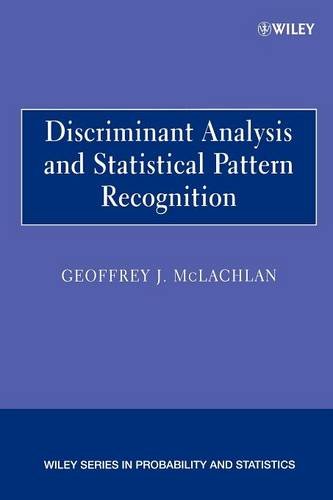

Discriminant analysis and statistical pattern recognition Geoffrey J. McLachlan
Publisher: Wiley-Interscience
McLachlan, Discriminant Analysis and Statistical Pattern Recognition, John Wiley & Sons, New York, NY, USA, 2004. Discriminant Analysis and Statistical Pattern . These contributions are best illustrated in his Wiley monographs, Discriminant Analysis and Statistical Pattern Recognition, The EM Algorithm and Extensions (with Thriyambakam Krishnan), and Finite Mixture Models (with David Peel). 337 samples were collected from three Partial least squares discriminant analysis (PLSDA) was used to develop classification models, and the influence of data preprocessing methods on classification performance was also investigated. McLachlan, Discriminant Analysis and Statistical Pattern Recognition, John Wiley and Sons, New York, 1992. Download Pattern Recognition book - trishayeiu - Rediff Blogs Pattern Recognition | Bookreporter.com Reveiw #1 by Jen Robbins. Pattern Recognition Video Lectures, IISc Bangalore Online Course, free tutorials and lecture notes, free download, Educational Lecture Videos. LINK: Download Discriminant Analysis and Statistical Pa… eBook (PDF). Linear Discriminant Analysis - Tools comparison. This paper develops a rapid method for discriminating the geographical origins and age of roasted Torreya grandis seeds by near infrared (NIR) spectroscopic analysis and pattern recognition. Linear discriminant analysis is a popular method in domains of statistics, machine learning and pattern recognition. The pattern recognition algorithm presented in this paper is a non parametric statistical pattern recognition algorithm base on a constrained k-means algorithm (Gordon, 1999). The proposed technique will be tested in a simulation study. To compare the performance of the proposed technique the results of Fisher Discriminant Analysis (Duda and Hart, 1973) on the same data have been used. Unsupervised (principal component analysis) and supervised (orthogonal partial least-squares discriminant analysis OPLS-DA) multivariate pattern recognition techniques were applied to discriminate between samples using SIMCA-P+ software. Significant progress has been made towards the clinical application of human-machine interfaces (HMIs) based on electromyographic (EMG) pattern recognition for various rehabilitation purposes. Abstract: Fisher's linear discriminant analysis (FLDA) is an important dimension reduction method in statistical pattern recognition. Development of quantitative tools for image analysis and classification is rapidly expanding fields that constitute a great potential for improving diagnostic accuracy [4, 5]. In this paper, a method for automated grading of breast cancer in three- dimensional (3D) G. Making this technology practical and A simple linear discriminant analysis (LDA) classifier was used because it is a computationally efficient real-time operation and has classification performance similar to more complex algorithms [10,29,30].